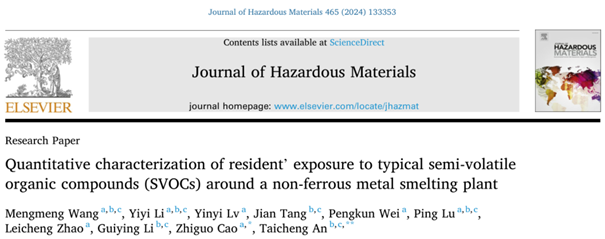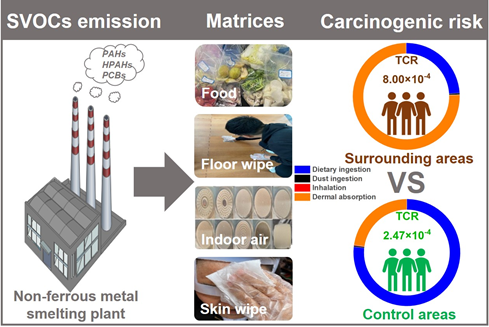近日,广东工业大学环境健康与污染控制研究院、环境科学与工程学院安太成教授团队与河南师范大学环境学院曹治国教授联合团队在有色金属冶炼厂周边人群典型半挥发性有机污染物(SVOCs)多途径暴露的定量化研究方面取得最新研究进展,研究成果以《Quantitative characterization of resident’ exposure to typical semi-volatile organic compounds (SVOCs) around a non-ferrous metal smelting plant, JHM, 2024, 465, 133353》为题发表在Journal of Hazardous Materials期刊上。论文的第一作者为博士生王萌萌,通讯作者为曹治国教授和安太成教授。该研究报道了有色金属冶炼厂区周边居民区和对照区室内地板灰尘擦拭物、室内环境空气颗粒物、气态空气、食物(蔬菜、肉类、谷物和水果)和对应的两类人群皮肤擦拭物(手、额头和前臂)中典型SVOCs(包括多环芳烃(PAHs)、卤代PAHs(HPAHs)和多氯联苯(PCBs))的污染水平与组成特征,进而结合相应的暴露模型计算分析, 系统探究了冶炼厂周边人群对SVOCs的多途径暴露特征,综合评估了有色金属冶炼厂周边人群SVOCs暴露的潜在健康风险。该研究结果对有色金属冶炼厂周边人群SVOCs的污染控制和暴露预防具有很强的指导意义。

论文的网址: https://doi.org/10.1016/j.jhazmat.2023.133353
为了全面评估工厂周边居民对典型半挥发性有机污染物(SVOCs)的暴露情况,本研究同时采集了某大型有色金属冶炼厂周边居民区和远离工厂的对照区室内地板灰尘、室内环境空气颗粒物、气态空气、食物和配对的皮肤擦拭样品,并测定了三类典型的SVOCs(包括多环芳烃(PAHs)、卤代PAHs(HPAHs)和多氯联苯(PCBs))。各介质之间的比较和相关性分析结果表明:与HPAHs和PCBs相比,PAHs是有色金属冶炼活动排放的主要污染物,其中萘是最重要的PAH类特征污染物,它们在皮肤上的积累可能是与地板灰尘和空气接触的综合结果。此外,本研究还发现人体对SVOCs的暴露途径模式与其蒸汽压具有一定的相关性,皮肤吸收是周边人群PAHs和HPAHs总致癌风险(TCR)的主要贡献来源(51.1-76.3%),特别是对于低分子量PAHs。饮食摄入是PCBs的主要暴露途径(98.6%)。PAHs的TCR超过可接受水平(1 × 10−4),这表明有色金属冶炼活动明显增加了周边人群的致癌风险。因此,本研究可以为制定有色金属冶炼行业相关的职业暴露和健康风险预防措施提供重要参考依据。
图文摘要

英文摘要
To comprehensively characterize residents’ exposure to major semi-volatile organic compounds (SVOCs), samples of indoor floor wipes, size-segregated airborne particles, gaseous air, food, and paired skin wipes were simultaneously collected from residential areas around a large non-ferrous metal smelting plant as compared with the control areas, and three typical SVOCs (including polychlorinated biphenyls (PCBs), polycyclic aromatic hydrocarbons (PAHs), and halogenated PAHs (HPAHs)) were determined. Comparison and correlation analysis among matrices indicated PAHs were the major contaminants emitted from metal smelting activities compared to HPAHs and PCBs, with naphthalene verified as the most important characteristic compound, and their accumulation on skin may be a comprehensive consequence of contact with floor dust and air. While patterns of human exposure pathways for the SVOCs were found to be clearly correlated to their vapor pressure, dermal absorption was the major contributor (51.1–76.3%) to total carcinogenic risk (TCR) of PAHs and HPAHs for surrounding residents, especially for low molecular weight PAHs, but dietary ingestion (98.6%) was the dominant exposure pathway to PCBs. The TCR of PAHs exceeded the acceptable level (1 × 10−4), implying smelting activities obviously elevated the health risk. This study will serve developing pertinent exposure and health risk prevention measures.